Striped Legless Lizard
Striped Legless LizardDelma impar | |
|---|---|
| Kingdom: | Animalia |
| Phylum: | Chordata |
| Class: | Reptilia |
| Order: | Squamata |
| Family: | Anatidae |
| Sub-Family: | Pygopodida |
| Status | |
| World: | Vulnerable (IUCN 2025) |
| Australia: | Vulnerable (EPBC Act 1999) |
| Victoria: | Endangered (FFG Threatened List - March 2025) |
| Vic. FFG: | Listed; Action Statement No. 17 |
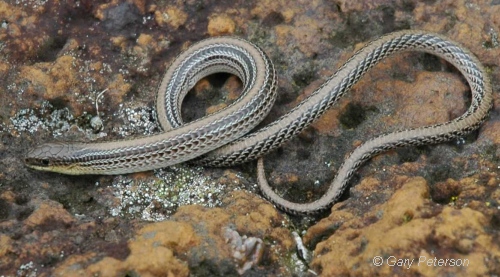
The Striped Legless Lizard Delma impar is a thin, snake-like lizard, growing up to 300mm, which is unique to the grasslands of south-eastern Australia. The Striped Legless Lizard is rarely seen as it shelters in soil cracks, in crevices under rocks, or in the base of grass tussocks.
Identification
The Striped Legless Lizard is pale grey to brown in colour with a dark head and often a yellow face and a series of light and dark brown parallel stripes running down the side of its body. The Striped Legless Lizard can be distinguished from snakes because no juvenile snakes in south east Australia have stripes along the entire length of the body.
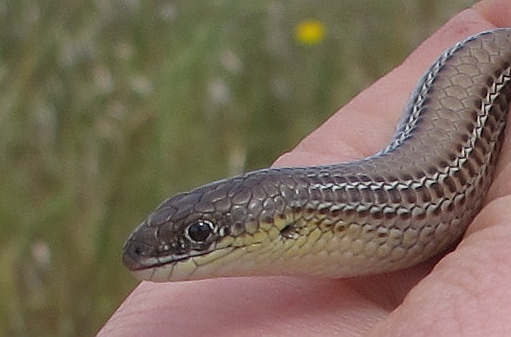
Distribution
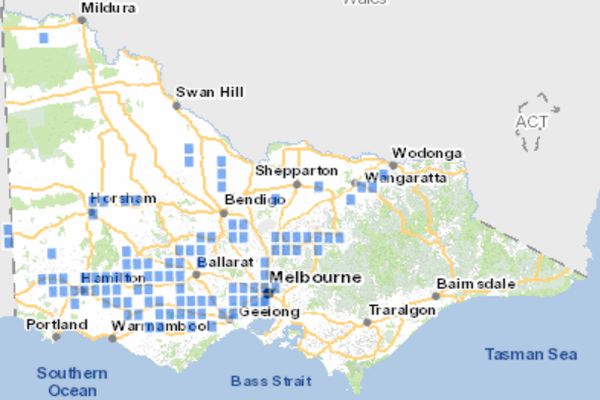
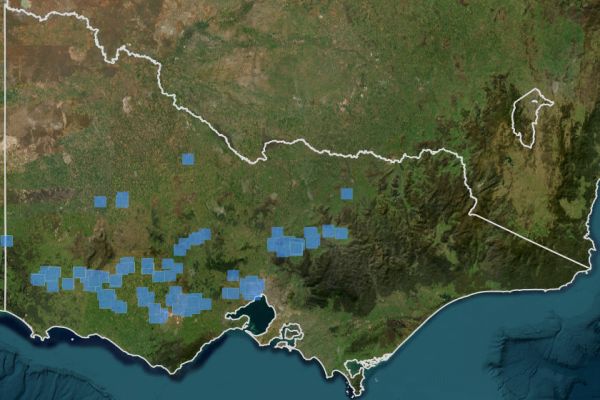
Ecology & Habitat
The Striped Legless Lizard lives predominantly in native grasslands dominated by tussock forming grasses such as Kangaroo Grass Themeda triandra or Spear Grass Stipa spp. and is mostly found on the Victorian Volcanic Plains. It has been found it in areas consisting of exotic grasses such as Phalaris, Serrated Tussock and pasture grasses but it is unknown how long it can persist in these exotic habitats.
The Striped Legless Lizard is a long lived species but rarely seen as it shelters in soil cracks, in crevices under rocks, or in the base of grass tussocks. The Striped Legless Lizard eats caterpillars, crickets, other insects, and spiders. It breeds in summer months and lays two eggs, which take about 5 months to hatch.
Threats
The major threat is loss of native grasslands habitat which is associated with, removal of rocks, pasture improvement, extended intense grazing, ploughing, frequent and ill-timed burning, weed invasion and urban development.
Conservation & Management
In Victoria, management of the Striped Legless Lizard is focused on about 68 priority grassland/grassy woodland sites which are grouped into clusters across its Victorian range ;
- north of Melbourne.
- western area of Melbourne including Mt Derrimut Nature Conservation Reserve and Ravenhall Nature Conservation Reserve and Deer Park Boral reserve.
- western Victorian Volcanic Plains
- north of Ballarat
- eastern Grampians
- Horsham area in the Wimmera grey cracking clays
- northern alluvial Plains
- North East slopes
- Alexandra area
- Gippsland area
- south-east of Bendigo
Many of the key sites are with Nature Conservation Reserves or Parks managed by Parks Victoria. However, there are also sites on private land, roadsides and rail reserves which require conservation.
Important Local Government Areas in Victoria for conservation of the Striped Legless Lizard
- Ararat Rural City
- Benalla Shire
- Brimbank City
- Colac Otway Shire
- Corangamite Shire
- Glenelg Shire
- Golden Plains Shire
- Greater Bendigo City
- Hobsons Bay City
- Horsham Rural City
- Hume City
- Melton City
- Moyne Shire
- Murrindindi Shire
- Northern Grampians Shire
- Pyrenees Shire
- Southern Grampians Shire
- Wangaratta Shire
- Whittlesea City
- Yarriambiack Shire
Protection of native grasslands on roadsides has been achieved in co-operation with various Local Government Areas on the Volcanic Plains. Advice to landholders with remnant grasslands has also meant protection of important habitat at many sites.

Management actions
Up until 2014 conservation efforts were primarily managed through the Striped Legless Lizard Project. which commenced in 2004 and finished in 2013, being replaced by the Linear Reserves Project.
Since 2014 the Linear Reserves project has focused on managing the health of important native grasslands through weed and biomass control. This type of ecological management has significantly enhanced some of the highest priority grassland reserves across the Corangamite CMA and Glenelg Hopkins CMA catchments. Ecological burning and sensitively reducing the cover and abundance of high threat weeds assists indigenous species to recolonise the remaining vacant areas which in turn benefits species such as the Striped Legless Lizard.
Projects & Partnerships
Striped Legless Lizard Project 2004 -2013
The project had a recovery team consisting of the DSE now Department of Environment, Land, Water and Planning (DELWP), RMIT University Ecology Research Group and Greening Australia.
Stage 1
Completion of a National Recovery Plan which included;
- Determining current distribution of Delma impar in Victoria
- Undertaking surveys of existing and potential habitat to determine the population status.
- Assessing the usefulness and suitability of a passive survey technique for surveying Delma impar.
- Developing a detection and survey protocol.
In 2004, 220 survey grids were established at native grassland sites throughout the Corangamite CMA and Glenelg Hopkins CMA. In 2005 the project was expanded to include 80 grids across the Wimmera Plain.
The survey grids consisted of 50 roof tiles arranged in a 20m x 45m grid with the corners of the grids marked by 1.5m-2m high wooden stakes. Grids were established to cover a variety of areas including 98 on roadsides, 118 in reserves, 82 on private property with each grid being monitored an average 10 times.
Roof tiles are used in surveys because the Striped Legless Lizards get under the roof tiles due to the tiles thermal properties, which allows successful sampling of this otherwise difficult-to-detect species.
Over the four years prior to 2008 each survey grid has been monitored an average of 14 times, which equates to about 4200 grids checked and about 210,000 tiles being lifted. Striped Legless Lizards were detected at 73 of 330 survey grids, >50% which are located on road reserves. Grassland reserves had about 30% and private property about 20% occurrence. The majority of these sites were previously unrecorded populations and hence the known distribution of the species has now been significantly expanded.
Knowledge on other small grassland fauna species has also been increased with 16 species of skink, seven species of snake, seven species of frog, another species of legless lizard, three gecko species, one dragon species and four species of small mammal also detected under the tiles. Special interest finds include the Curl Snake, Mitchell’s Short-tailed Snake, Tessellated Gecko, Thick-tailed Gecko, Little Whip Snake and Fat-tailed Dunnart.
During the 2008 spring surveys, tail tips were sampled for genetic research. An understanding of genetic diversity is necessary as many populations of Striped Legless Lizard are isolated from each other.
Stage 2
The second stage of the project had an emphasis on understanding the population characteristics of the Striped Legless Lizard, which can be used to determine on-ground management. Habitat modelling to assess what factors influence the distribution and persistence of the Striped Legless Lizard was also carried out. This is used to determine appropriate habitat management for the species such as weed control, altered grazing regimes, and specific fire regimes.
Management is adaptive and done in partnership with the land manager. Habitat models also assist in determining sites where the species may be present, but had not been previously surveyed. These sites were assessed and where suitable surveyed using the standard tile grid method.
In 2011 at least 42 broad locations were the focus of monitoring which included about 300 individual survey sites across south-western Victoria.
Key activities undertaken during stage 2
Monitoring and habitat protection.
- Assess and identify potential threats to the Striped Legless Lizard and its habitat as they arise.
- Prevent habitat loss by implementing appropriate management actions to alleviate any threats and restore Striped Legless Lizard habitat if required.
- Undertake population monitoring at least three times per year via the roof tile grid method, including capture-mark-recapture.
- Control weed invasion of Striped Legless Lizard habitat; problem weeds include Serrated Tussock and Phalaris.
- Liaise with CFA, Corangamite Shire, Golden Plains Shire and landholders, particularly in regard to promoting the burning of roadsides on a 3 year cycle where Striped Legless Lizard is known to occur.
- At several sites undertake habitat assessment once every three years via photo plot monitoring.
- At several sites undertaken autumn mosaic ecological burns to reduce grassland biomass accumulation. Rotate burns through any one area no more than once every three years.
- Where necessary fence areas of Striped Legless Lizard habitat to exclude or regulate stock grazing and allow regeneration/revegetation of grassland species.
Research
- Assess Striped Legless Lizard microhabitat preferences at twenty two survey grids across Cluster 3a (western Volcanic Plains)
- Undertake habitat characteristic predictive modelling.
- Assess population demographics of Striped Legless Lizard via capture-mark-recapture.
- Investigate the effect of grazing exclusion on habitat
- Assess the effect of fire and its frequency on Striped Legless Lizard and its habitat
- At Cluster 3a (western Volcanic Plains) undertake surveys at 130 sites, including all historical Striped Legless Lizard localities by establishing tile survey grids at or close to each historical locality.
- Undertake surveys of potential Striped Legless Lizard habitat at 96 sites across Cluster 3b (eastern Volcanic Plains
- Undertake surveys of potential Striped Legless Lizard habitat at 10 sites across Cluster 5 (east Grampians).
In 2011 / 2012 the focus was to continue on with intense monitoring at the existing Striped Legless Lizards populations to increase knowledge of population demographic information from the mark-capture-recapture work, enabling estimates of population abundances, recruitment, survivorship, growth rates and sex and age ratios to be calculated.
In 2012/13 the project focused on tracking individuals by monitoring seven of the best 20 Striped Legless Lizard sites within the Corangamite CMA. The seven sites where chosen because they had the highest capture rates since the monitoring began in 2004. The monitoring at these sites was increased from three times a year to five.
Since the beginning of the long-term surveys and monitoring of the Striped Legless Lizard across the Corangamite region, each individual lizard captured has been photographed for individual recognition. This has allowed tracking of individuals across years to learn more about their longevity, growth rates and movements across the survey grid.
In 2012/13 a number of Striped Legless Lizard sites were added to the CFA grassland fire operations planning system which enables assists in determining priority areas for ecological burning.
During 2012 / 2013 a Survey and Monitoring Protocol for the Striped Legless Lizard was developed for distribution to stakeholders involved in surveys. The protocol allows for a consistent approach to monitoring for this species and outlines minimum requirements for species detection. Such minimum standards are very important for cryptic species which can be easily missed when survey effort is low.
Linear reserves project
This project replaced the previous Stripe Legless Lizard project in 2014. A key objective of the Linear Reserves Project is to manage the health of grasslands through weed and biomass control.
During 2014/15 grassland vegetation condition monitoring was conducted at over forty sites across the GHCMA and CCMA. Twenty of these sites were subsequently treated for weeds, while the remaining twenty sites acted as control sites where no weed treatment was undertaken. All forty sites will be monitored annually over the life of the project to measure change in vegetation condition following weed treatment.
During 2014/15 approx. 69 hectares or 23 km of high conservation value grasslands road reserves were treated for annual and perennial weeds across CCMA and GHCMA.
This activity has significantly enhanced some of the catchments highest priority grassland reserves by sensitively reducing the cover and abundance of high threat weeds and promoting indigenous species to recolonise the remaining vacant areas. Follow up treatment is scheduled in coming years.
Ecological burns were conducted at 17 native grassland sites with approximately 195 ha being successfully treated.
In 2019/20 ecological burns were carried out at Forest Lane, near Dunkeld and the Cressy Flora Reserve (Trotting Track) led by Forest Fire Management Victoria (FFMVic). This burn will form part of a 3-year burning regime.
During 2019/20 targeted weed control was carried out on 29 Linear Reserves totalling 1,354 ha of weed control.
Striped Legless Lizard salvage and translocation project
Urban growth in the Melbourne area will result in the removal of approximately 7,000 hectares of native grassland. The Federal and State governments have prescribed that as the development progresses Striped Legless Lizards in these areas will be salvaged and translocated to suitable native grassland habitat in the new 15,000 ha Western Grassland Reserve. The first lizards were translocated in 2013.
A project to evaluate the effectiveness of salvage and translocations is being conducted by the Arthur Rylah Institute. Three monitoring zones have been created, with the greatest intensity of post-release monitoring to be conducted around soft-release enclosures. Within each zone there will be four points of monitoring that are randomly located each year.
In order to robustly evaluate the success or failure of translocation, the project will require at least 900 Striped Legless Lizards to be released in groups of 75 across 12 replicated recipient sites, with a minimum of three sites per release event.
Measuring translocation success
- a target of 87% adult survival within each of the study years.
- evidence of lizards that have hatched at the release site, within two years of the release of founders.
- evidence of reproduction (i.e. gravidity or hatched offspring) in first generation natives at about year five.
- hatchlings are derived from a range of adult animals (This will be determined through genetic screening).
Wurdi Youang (Little River Farm)
This is a 369 ha Indigenous Protected Area establish in 2006 which contains native grasslands supporting the Striped Legless Lizard and managed by the Wathaurong Aboriginal Co-operative. Tile surveys, education and active management for the Striped Legless Lizard is undertaken at this site.
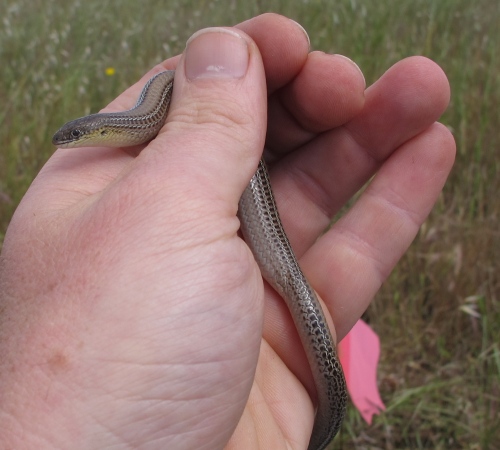
Partnerships involved with conservation of Striped Legless Lizards
- Victorian Striped Legless Lizard Working Group (Biosis Research Pty. Ltd, Department of Environment, Land, Water & Planning, Friends of the Striped Legless Lizard, University of Melbourne, Victorian National Parks Association, Victorian University of Technology, Wildlife Profiles Pty. Ltd, Zoos Victoria)
- Parks Victoria, Greening Australia, VicRoads, Moyne Shire, Southern Grampians Shire, Corangamite Shire, Golden Plains Shire, V/Line Pty Ltd., CFA, various Committees of Management and interested landholders.
- Catchment Management Authorities.
- Wathaurong Aboriginal Co-operative - Wurdi Youang Indigenous Protected Area.
- Community groups with the monitoring of Striped Legless Lizard survey grids.
- Landholders undertaking native grassland management.
- University of Ballarat.
Summary
There is now a much greater understanding of Striped Legless Lizard populations across Victoria, in particular western Victoria.
Monitoring and capture-recapture data on Striped Legless Lizards has helped to determine population demographics such as population abundances, recruitment, survivorship, growth rates and sex and age ratios.
The most efficient time to survey for Striped Legless Lizards is October to November.
Wimmera Catchment - the Striped Legless Lizard is only known from 4 locations out of 89 survey sites within the Wimmera, these are highly fragmented populations in severely degraded habitat.
Corangamite catchment - the Striped Legless Lizard has been recorded at 21 sites out of 76 survey sites.
Glenelg Hopkins catchment - the Striped Legless Lizard has been recorded at 48 out of 89 survey sites.
Management achievements
Priority Striped Legless Lizard sites have been added to the CFA grassland fire operations planning system which enables priority sites to be selected for ecological burning.
The effect of fire on roadside fauna is much better understood, including the development of appropriate fire regimes for Striped Legless Lizard as well as other grassland fauna and flora.
Native grasslands are endangered, and are critically important for not only the Striped Legless Lizard but many other threatened plants and animals. Native grasslands require active management and regular burning; Late summer or early autumn every 3 years is the desired approach. Continued burning by the CFA is therefore encouraged.
Striped Legless Lizard sites have been mapped for the purpose of municipal planning schemes and consideration of Environmental Significance Overlays (ESO) are progressing over a number of sites within Moyne Shire, Corangamite Shire and Colac Otway Shire.
Emphasis on managing weed and rabbit control has been included into Striped Legless Lizard management.
Research
Findings from research into the occupancy of Stripped Legless Lizards from 291 sites over 9 years.
Scroggie, M.P., Peterson, G.N.L., Rohr, D.H. et al. Disturbance has benefits as well as costs for fragmented populations of a cryptic grassland reptile. Landscape Ecol 34, 1949–1965 (2019). https://doi.org/10.1007/s10980-019-00865-0
Researchers found the use of fire and grazing to manage fragmented grasslands can be beneficial for the persistence of D. impar populations, but intense and concurrent application of both these disturbances may trigger population collapse.
If you see a roof tile in native grassland please do not disturb and know it is part of the survey.
More Information
National Recovery Plan for Striped Legless Lizard 1999 -2003
Victorian Flora & Fauna Guarantee Action Statement No. 17
Department of Environment, Species profile & threats database -Striped Legless Lizard
Conservation Advice Delma impar - Threatened species scientific committee 2016
VVB (2025) Visualising Victoria's Biodiversity map portal.
Please contribute information regarding Striped Legless Lizard in Victoria - observations, images or projects. Contact SWIFFT

